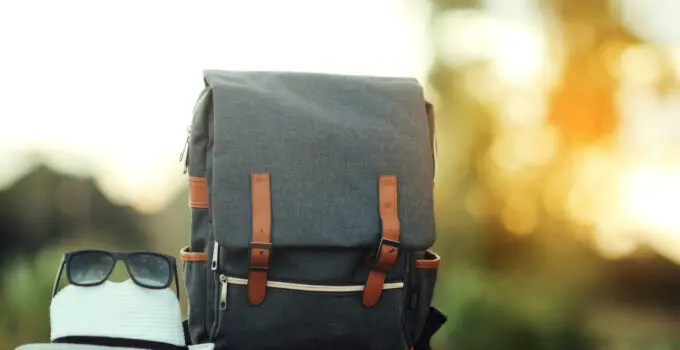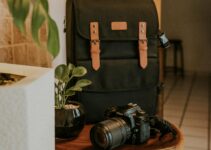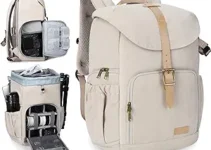Are you tired of carrying separate bags for your camera and insulated items?
Discover how to create an insulated camera bag that keeps your gear safe and your snacks cool on the go.
In just a few steps, you can transform an ordinary camera bag into a dual-purpose essential.
By adding insulated lining and compartments, your bag becomes a versatile companion for photography outings and picnics alike.
Curious to learn the exact process and materials needed? Join us as we delve into the specifics of crafting the perfect insulated camera bag.
Here how to turn a backpack into a camera bag?
Let’s turn your ordinary bag into a must-have accessory for any photographer or adventurer.
Why you need a insulated camera bag?
An insulated camera bag serves several crucial purposes for photographers.
Firstly, it protects sensitive camera equipment from extreme temperatures, both hot and cold, which can damage electronic components and lenses.
This insulation helps maintain a stable internal environment, preventing condensation in cold weather and excessive heat in hot climates.
Secondly, an insulated camera bag provides cushioning and shock absorption, reducing the risk of impact damage during transport or accidental drops.
This is especially important for delicate lenses and fragile accessories.
Additionally, insulated camera bags often come with customizable compartments and padded dividers, allowing photographers to organize their gear efficiently and securely.
This organization prevents equipment from shifting or bumping into each other, further minimizing the potential for damage.
Here, how to clean a lululemon camera bag.
Overall, investing in an insulated camera bag ensures the longevity and optimal performance of expensive camera gear, making it a wise choice for professional and amateur photographers alike.
Is insulated camera bag worth it?
An insulated camera bag provides essential protection and benefits to camera gear in several ways:
- Temperature Regulation: Insulation helps maintain a stable internal temperature, shielding gear from extreme heat or cold that can damage sensitive electronics and batteries. It also reduces the risk of condensation forming inside the bag, which can harm lenses and camera bodies.
- Shock Absorption: Insulated bags typically have padded compartments and dividers that cushion equipment against impacts during transport or accidental drops. This padding absorbs shocks, reducing the likelihood of damage to lenses, sensors, and other delicate components.
- Moisture Protection: In humid environments or during sudden weather changes, insulated bags provide a barrier against moisture. This helps prevent water damage to gear, including rusting of metal parts and electrical malfunctions.
- Organizational Benefits: Many insulated bags offer customizable compartments and secure fastenings, allowing photographers to organize their gear efficiently. This organization minimizes the risk of equipment bumping into each other, reducing scratches and dings.
Overall, an insulated camera bag ensures the longevity and optimal performance of camera gear by protecting it from temperature variations, impacts, moisture, and providing organized storage.
Here, how to make a bean bag for camera support?
7 Reasons to use insulated camera bag
1. Temperature Control
An insulated camera bag is designed to regulate the internal temperature of your camera gear.
This is particularly crucial in environments where temperatures fluctuate drastically or reach extreme levels.
Temperature control helps prevent damage to sensitive electronic components such as batteries and sensors, which can malfunction or degrade when exposed to excessive heat or cold.
Moreover, maintaining a stable temperature inside the bag minimizes the risk of condensation forming on lenses and camera bodies, which could lead to water damage and fungus growth over time.
2. Protection from Impact
One of the primary advantages of an insulated camera bag is its ability to provide superior protection from impacts.
The bag’s padded compartments and dividers act as shock absorbers, cushioning your gear against bumps, drops, and other physical impacts during transportation or handling.
This feature is especially beneficial for delicate lenses, fragile accessories, and expensive camera bodies, as it significantly reduces the risk of scratches, dents, or internal damage caused by sudden jolts or falls.
3. Moisture Resistance
In addition to temperature control, insulated camera bags offer excellent moisture resistance. They create a barrier that protects your gear from moisture, humidity, and even light rain or splashes.

This moisture resistance is crucial for preventing water damage, rusting of metal parts, and potential electrical malfunctions.
It’s particularly valuable for outdoor photographers who often encounter unpredictable weather conditions or shoot in humid environments where moisture can seep into unprotected camera equipment.
4. Durability Enhancement
Using an insulated camera bag can significantly enhance the overall durability of your gear.
By shielding it from extreme temperatures, impacts, and moisture, the bag helps prolong the lifespan of your cameras, lenses, and accessories.
This added durability not only protects your investment but also ensures that your equipment remains in optimal working condition for longer periods, reducing the frequency of repairs or replacements.
5. Organized Storage
Insulated camera bags typically come with customizable compartments, padded dividers, and secure fastenings that facilitate organized storage of your gear.
This organizational feature allows you to arrange your cameras, lenses, batteries, memory cards, and other accessories efficiently.
By keeping everything in its designated place, the bag minimizes the risk of equipment shifting or colliding during transit, which can cause scratches, misalignments, or other damages.
6. Travel Convenience
For photographers who travel frequently or work in different locations, an insulated camera bag offers unparalleled convenience.
Here, how to remove mold from a camera bag?
Its protective features, combined with ergonomic designs and comfortable carrying options (such as padded straps or handles), make it easy to transport your gear safely and comfortably.
Whether you’re navigating crowded airports, rugged landscapes, or urban environments, a well-designed insulated bag ensures that your equipment remains secure and accessible throughout your journeys.
7. Professional Image
Using an insulated camera bag also contributes to projecting a professional image as a photographer.
Clients, colleagues, and fellow professionals often associate a well-maintained, organized, and protected gear setup with professionalism and attention to detail.
By investing in an insulated bag that prioritizes the safety and longevity of your camera equipment, you not only safeguard your gear but also convey a sense of reliability, professionalism, and commitment to quality in your work.
This can positively impact how others perceive your expertise and dedication to your craft.
How to make a bag insulated camera bag?
To convert a regular bag into an insulated camera bag, follow these steps:
- Choose the Right Bag: Select a bag that fits your camera gear comfortably and has sufficient space for insulation materials.
- Gather Insulation Materials: Purchase foam padding, bubble wrap, or insulated liners designed for bags. Ensure the materials are thick enough to provide adequate protection.
- Measure and Cut: Measure the interior compartments of the bag and cut the insulation materials to fit snugly inside. Pay attention to the main compartments, dividers, and any additional pockets.
- Line the Bag: Line the bottom, sides, and dividers of the bag with the insulation materials. Use adhesive or sewing to secure them in place, ensuring a tight fit without obstructing access to gear.
- Add Extra Protection: Consider adding extra padding around sensitive equipment such as lenses or camera bodies. You can use foam inserts or wrap items in bubble wrap for additional cushioning.
- Test and Adjust: Place your camera gear in the bag and test the fit. Make any necessary adjustments to ensure everything is well-protected and organized.
- Secure Closure: Ensure the bag has a secure closure system, such as zippers, buckles, or Velcro, to prevent gear from shifting during transport.
By following these steps and using suitable insulation materials, you can transform a regular bag into an insulated camera bag to protect your gear from temperature fluctuations, impacts, and moisture.
Here, how to clean a lowepro camera bag?
9 steps to make a bag insulated camera bag
1. Select the Right Bag
Choosing the appropriate bag is crucial for creating an insulated camera bag.
Opt for a bag that not only fits your camera gear comfortably but also has sufficient room for insulation materials. Consider factors like compartment size, accessibility, durability, and carrying comfort.
Backpacks, shoulder bags, and messenger-style bags can all be converted into insulated camera bags, depending on your preferences and needs.
2. Gather Insulation Materials
Next, gather the necessary insulation materials. Foam padding, bubble wrap, insulated liners, or specialized camera bag inserts are all suitable options.
Ensure the materials are thick enough to provide adequate protection against temperature fluctuations, impacts, and moisture. You may also need adhesive, scissors, and a measuring tape for the insulation process.
3. Measure and Cut
Measure the interior compartments of the bag carefully. This includes the main storage area, dividers, and any additional pockets or compartments.
Use these measurements to cut the insulation materials to the appropriate size. Precision is key to ensure the insulation fits snugly inside the bag without causing overcrowding or hindering access to your camera gear.
4. Line the Bag
Start lining the interior of the bag with the insulation materials. Begin with the bottom of the main compartment and then move on to the sides and dividers.
Use adhesive to secure the insulation in place, ensuring a tight fit that covers all areas where your camera gear will be stored. Avoid leaving gaps or loose sections that could compromise the insulation’s effectiveness.
5. Secure Dividers and Pockets
If your bag has removable dividers or additional pockets, ensure they are also lined with insulation materials.
This provides comprehensive protection for all parts of your camera gear. Use adhesive or sewing to secure the insulation to these components, ensuring they remain firmly in place during use.
6. Add Extra Padding
Consider adding extra padding to specific areas that require additional protection.
For example, wrap delicate lenses or camera bodies in foam inserts or bubble wrap before placing them in the insulated compartments. This extra layer of cushioning helps safeguard sensitive equipment from impacts and shocks.
7. Test the Fit
Once you’ve lined the bag with insulation and added extra padding as needed, test the fit by placing your camera gear inside. Ensure everything fits comfortably and securely without being too tight or crowded.
Check that the insulation adequately covers and protects each item, especially vulnerable components like lenses and screens.
8. Secure Closure Systems
Make sure the bag has a secure closure system, such as zippers, buckles, or Velcro.
This prevents gear from shifting or falling out during transport, maintaining the protective barrier created by the insulation. Check that the closure system is sturdy and functions smoothly without any snags or weaknesses.
9. Finalize and Customize
After testing and ensuring everything is in place, finalize the insulation process by securing any loose ends or edges. Trim excess insulation material if necessary to maintain a neat and organized interior.
Customize the bag further by adding labels, tags, or personal touches to distinguish it as your insulated camera bag.
By following these nine steps with attention to detail and quality materials, you can successfully transform a regular bag into a fully functional and protective insulated camera bag, tailored to your specific equipment and photography needs.
Related faq’s
How to make your own insulated bag?
To make your own insulated bag, follow these steps:
- Gather Materials: Collect sturdy fabric for the outer shell, insulation material like foam or insulated batting, lining fabric, a zipper or closure system, and sewing supplies.
- Cut Fabric: Cut the outer fabric, lining fabric, and insulation material to the desired size and shape based on your bag design.
- Sew Layers Together: Layer the outer fabric, insulation, and lining fabric together. Sew around the edges, leaving an opening for turning the bag right side out.
- Add Closure: Attach a zipper or closure system to the opening to secure the bag.
- Create Compartments: If desired, sew dividers or pockets inside the bag using the lining fabric to create compartments for organization.
- Finish Seams: Finish the seams inside the bag to prevent fraying and add durability.
- Test and Customize: Test the bag’s insulation by placing items inside and ensuring they stay protected. Customize the bag with straps, handles, or decorations as desired.
- Final Touches: Trim any excess threads, reinforce seams if needed, and ensure the bag is fully functional and insulated.
By following these steps, you can create your own insulated bag tailored to your specific needs and preferences.
What is an insulated bag made of?
Insulated bags are typically made of several layers of materials designed to provide thermal insulation and protection. The main components include:
- Outer Shell: The outer layer of the insulated bag is often made of durable and water-resistant fabric such as nylon, polyester, or canvas. This layer helps protect the insulation and contents of the bag from external elements like moisture, dust, and abrasions.
- Insulation Material: The insulation layer is the core component that provides thermal resistance. Common insulation materials used in insulated bags include foam padding, insulated batting, thermal liners, or specialized insulating fabrics. These materials trap air and create a barrier against heat transfer, helping maintain a stable internal temperature.
- Lining Fabric: The inner lining of the bag is usually made of a soft and easy-to-clean fabric like polyester or nylon. This lining protects the insulation and provides a smooth interior surface for storing and accessing items without snagging or damage.
In summary, an insulated bag combines an outer shell for durability, insulation material for thermal resistance, and a lining fabric for comfort and protection, creating a versatile and effective solution for transporting temperature-sensitive items.
How to make a cooler bag cold?
To make a cooler bag effectively cold, follow these steps:
- Pre-Chill the Cooler: Before use, pre-chill the cooler by placing ice packs or frozen water bottles inside for a few hours. This helps lower the internal temperature of the cooler and creates a cold environment for your items.
- Use Proper Insulation: Ensure your cooler bag has adequate insulation. High-quality insulated bags with thick walls and proper seals are more effective at maintaining cold temperatures.
- Pack Cold Items First: Place pre-chilled items like beverages, perishable foods, and ice packs at the bottom of the cooler. This ensures they stay cold longer and helps distribute the cold throughout the bag.
- Add Ice or Ice Packs: Layer ice or ice packs on top of the cold items. Crushed ice works well for filling gaps and maximizing cold contact.
- Minimize Air Gaps: Fill any empty spaces with additional ice packs or crumpled paper to minimize air circulation inside the cooler, which can accelerate temperature warming.
- Keep the Cooler Closed: Limit opening the cooler frequently to maintain cold temperatures. When accessing items, close the cooler lid promptly to retain coldness.
- Avoid Direct Sunlight: Place the cooler in a shaded area away from direct sunlight or heat sources. Sun exposure can increase the internal temperature of the cooler and reduce its cooling efficiency.
By following these steps, you can effectively keep your cooler bag cold and ensure your perishable items remain chilled for extended periods, making it ideal for picnics, outdoor activities, and transporting temperature-sensitive goods.
How do you pack an insulated bag?
Packing an insulated bag efficiently involves several steps to ensure proper organization, optimal insulation, and effective use of space:
- Prepare Cold Items: If packing perishable items or items that need to stay cold, pre-chill them in the refrigerator or freezer beforehand.
- Use Ice Packs or Frozen Items: Place ice packs or frozen items like gel packs, frozen water bottles, or freezer blocks at the bottom of the bag. These help maintain a cold temperature inside.
- Layer Cold Items: Place pre-chilled items directly on top of the ice packs or frozen items. This maximizes cold contact and keeps perishables colder longer.
- Separate Temperature-Sensitive Items: If packing both cold and room temperature items, use separate compartments or containers to prevent temperature transfer.
- Fill Empty Spaces: Fill any gaps or empty spaces in the bag with additional ice packs, crumpled paper, or towels. Minimizing air pockets helps maintain insulation.
- Organize and Stack: Arrange items neatly and stack them if possible, with heavier items at the bottom and delicate items on top to prevent crushing or damage.
- Zip or Seal Properly: Close the bag securely to retain coldness and prevent air from entering or escaping.
By following these steps, you can pack your insulated bag effectively to keep cold items chilled and ensure organization and protection for your belongings during transportation
Conclusion:
To make an insulated camera bag, you’ll need materials like foam insulation, fabric, and a sewing machine.
Measure and cut the foam to fit the bag, then sew it into the lining. This will help protect your camera gear from temperature fluctuations. Happy shooting!








